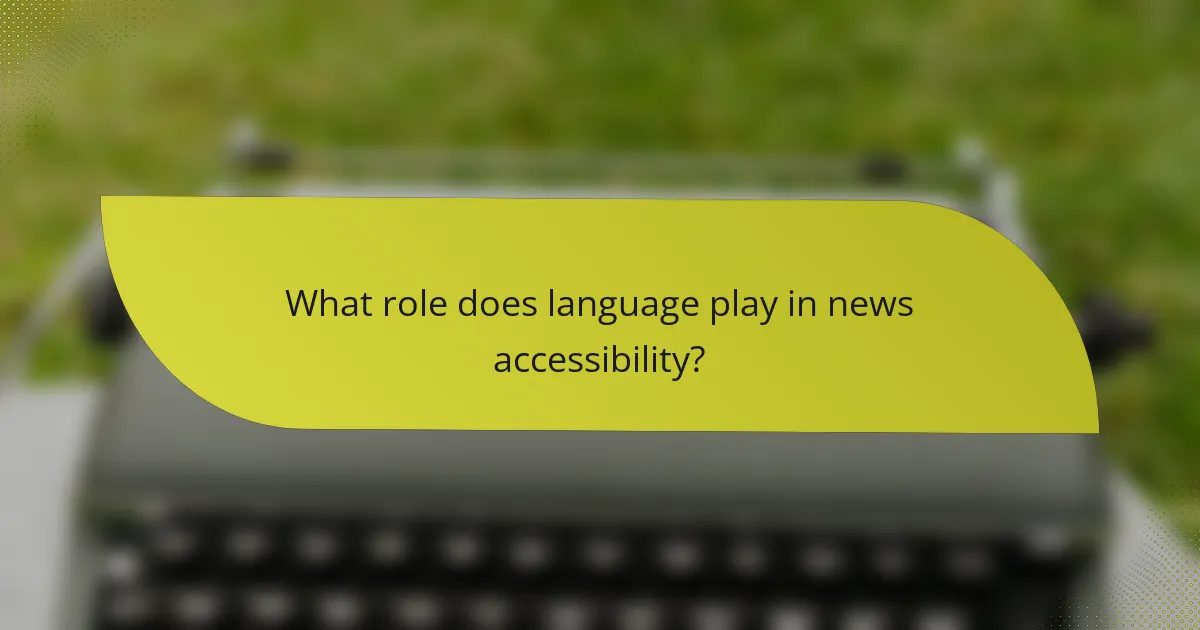Breaking world news updates play a vital role in enhancing audience engagement by providing timely information that captivates and encourages interaction. The use of accessible language is essential for ensuring that diverse audiences can easily understand and connect with the content, regardless of their language proficiency. By leveraging various platforms, such as social media and news apps, news organizations can create immersive experiences that keep users informed and involved.

How can breaking world news updates improve audience engagement?
Breaking world news updates enhance audience engagement by delivering timely information that captures attention and encourages interaction. By utilizing various features, news platforms can create a more immersive experience, keeping users informed and involved.
Real-time notifications
Real-time notifications alert users to breaking news as it happens, ensuring they receive updates instantly. This immediacy can significantly increase user engagement, as people are more likely to interact with content that feels urgent and relevant.
To implement effective notifications, consider allowing users to customize their preferences based on topics of interest or geographical relevance. This way, they receive only the most pertinent updates, enhancing their overall experience.
Interactive content features
Interactive content features, such as polls, quizzes, and live discussions, encourage users to engage actively with news stories. These elements not only make the news more engaging but also provide valuable feedback and insights into audience opinions and preferences.
For example, incorporating a live Q&A session with experts during significant events can foster a sense of community and connection among users, making them feel more invested in the news being reported.
Personalized news feeds
Personalized news feeds tailor content to individual user preferences, increasing the likelihood of engagement. By analyzing user behavior and interests, news platforms can curate a selection of articles that resonate with each reader, making the experience more relevant.
To maximize the effectiveness of personalized feeds, consider using algorithms that adapt over time based on user interactions. This continuous learning process helps ensure that the content remains fresh and aligned with audience interests, ultimately driving higher engagement rates.

What role does language play in news accessibility?
Language is crucial for news accessibility as it determines how easily diverse audiences can understand and engage with content. Effective communication in news reporting ensures that information is accessible to individuals regardless of their language proficiency or literacy levels.
Multilingual content offerings
Providing news in multiple languages enhances accessibility for non-native speakers and diverse communities. News organizations can reach broader audiences by translating articles or offering audio and video content in various languages. For instance, a news outlet might publish articles in English, Spanish, and Mandarin to cater to different demographic groups.
When creating multilingual content, consider using professional translators or native speakers to ensure accuracy and cultural relevance. Automated translation tools can be helpful but may lack nuance, so human oversight is essential for maintaining quality.
Use of simple language
Using simple language in news articles makes information more digestible for readers with varying literacy levels. This approach involves avoiding jargon, complex sentence structures, and technical terms that may confuse audiences. For example, instead of saying “utilize,” one might say “use” to convey the same idea more clearly.
To implement this strategy, writers should aim for short sentences and straightforward vocabulary. A good practice is to keep the reading level at or below the 8th-grade level, which can help ensure that the content is accessible to a wider audience. Regularly reviewing and revising content for clarity can significantly enhance reader engagement.

Which platforms are best for delivering breaking news updates?
The best platforms for delivering breaking news updates include social media, news aggregator apps, and broadcast news channels. Each platform has unique strengths that cater to different audience preferences and engagement styles.
Social media platforms
Social media platforms like Twitter, Facebook, and Instagram are highly effective for real-time news dissemination. They allow news organizations to share updates instantly, reaching millions of users quickly through shares and retweets.
When using social media for breaking news, prioritize concise messaging and engaging visuals. Consider using hashtags to enhance visibility and encourage audience interaction, but avoid overwhelming users with excessive posts.
News aggregator apps
News aggregator apps such as Google News and Flipboard compile articles from various sources, providing users with a personalized news feed. These platforms enable users to customize their preferences, ensuring they receive updates on topics of interest.
To maximize engagement on aggregator apps, ensure your content is optimized for searchability and includes eye-catching headlines. Regularly update your articles to maintain relevance and encourage users to return for the latest information.
Broadcast news channels
Broadcast news channels, including cable and satellite networks, remain a trusted source for breaking news, especially during major events. They provide in-depth coverage and expert analysis, appealing to audiences who prefer traditional media formats.
For effective delivery on broadcast channels, focus on clear, authoritative reporting. Utilize graphics and live updates to enhance storytelling and keep viewers informed in real-time. Consider the timing of broadcasts to align with peak viewing hours for maximum reach.

How do accessibility features enhance news consumption?
Accessibility features significantly improve news consumption by making information more inclusive for individuals with disabilities. These tools ensure that everyone, regardless of their abilities, can engage with news content effectively and understand current events.
Text-to-speech technology
Text-to-speech (TTS) technology converts written text into spoken words, allowing users to listen to news articles instead of reading them. This is particularly beneficial for individuals with visual impairments or reading difficulties, as it provides an alternative way to access information.
Many news websites and apps now integrate TTS features, enabling users to customize playback speed and voice selection. Users should look for platforms that offer high-quality, natural-sounding voices to enhance the listening experience.
Closed captioning services
Closed captioning services display text on the screen that corresponds to spoken dialogue in videos, making news broadcasts accessible to individuals who are deaf or hard of hearing. This feature not only aids comprehension but also allows viewers to follow along in noisy environments.
When selecting news sources, ensure they provide accurate and timely closed captions. Look for services that comply with accessibility standards, as this can improve the overall viewing experience and ensure that all viewers receive the same information simultaneously.

What are the key criteria for selecting news sources?
When selecting news sources, prioritize credibility, trustworthiness, and coverage diversity. These criteria ensure that the information you receive is accurate, balanced, and representative of various perspectives.
Credibility and trustworthiness
Credibility refers to the reliability of a news source, while trustworthiness indicates how much you can depend on it for accurate information. Look for sources that have a history of factual reporting and are transparent about their editorial processes.
Check for affiliations with recognized journalism organizations and adherence to established ethical standards. Sources that provide citations and references to their claims tend to be more reliable.
Coverage diversity
Coverage diversity involves the range of topics and viewpoints presented by a news source. A diverse news source covers various issues, including politics, economics, culture, and social matters, offering a well-rounded perspective.
To ensure you are getting a comprehensive view, consider sources that represent different political orientations and cultural backgrounds. This approach helps to avoid echo chambers and promotes a more informed understanding of current events.

How does audience feedback shape news content?
Audience feedback significantly influences news content by guiding editorial decisions and shaping the topics covered. News organizations actively seek input from their viewers and readers to ensure that their reporting aligns with audience interests and needs.
Surveys and polls
Surveys and polls are essential tools for gathering audience feedback on news content. They allow news organizations to assess public opinion on various topics, helping editors understand what stories resonate most with their audience. For instance, a news outlet might conduct a survey to determine which political issues are most important to its viewers.
When designing surveys, it’s crucial to keep questions clear and concise to avoid confusion. Using a mix of multiple-choice questions and open-ended responses can provide both quantitative and qualitative insights. For example, a poll might ask, “Which recent news story impacted you the most?” followed by options to select and a space for additional comments.
Regularly analyzing survey results can help news organizations adapt their content strategy. By identifying trends in audience preferences, they can prioritize coverage on topics that matter most, ultimately enhancing engagement and viewer loyalty.
